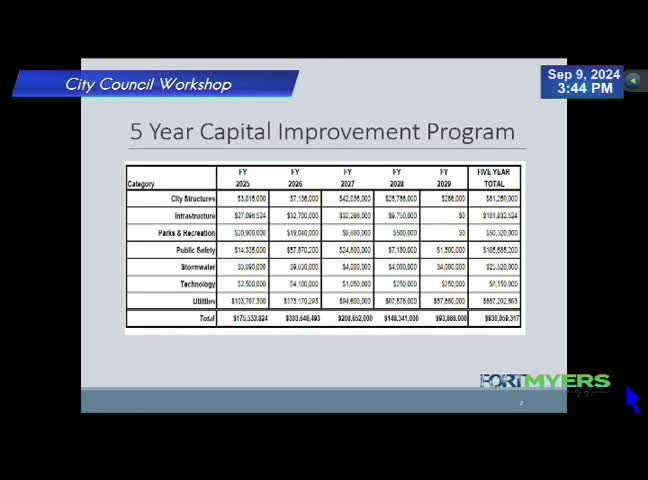City launches historic $930 million capital improvement plan
September 09, 2024 | Fort Myers City, Lee County, Florida
This article was created by AI summarizing key points discussed. AI makes mistakes, so for full details and context, please refer to the video of the full meeting. Please report any errors so we can fix them. Report an error »

The city’s five-year capital improvement program for fiscal years 2025 through 2029 has reached a historic high, totaling $930 million, marking the largest investment seen in the last two decades. The proposed budget for fiscal year 2025 alone includes $175.5 million in new funding, primarily aimed at advancing ongoing projects rather than initiating new ones.
As the current fiscal year approaches its end, the city anticipates a carryover of over $200 million into the next budget cycle, potentially bringing the total capital budget for 2025 to nearly $400 million. This substantial financial commitment is essential for completing significant projects already in progress, including the STARS complex, improvements to the Winkler corridor, and the construction of a new police department facility.
The meeting highlighted the necessity of incurring debt to fund these ambitious projects, with a significant portion of the budget allocated to utility and governmental debt. The city currently holds a $30 million line of credit, with approximately $17.4 million available for future projects. This line of credit is expected to be utilized alongside new debt issuances to finance the ongoing and upcoming projects, including the police headquarters, which alone is projected to cost over $90 million.
In addition to capital projects, the budget for 2025 includes $11.7 million for operating projects, funded through various operating budgets. Key allocations include $2 million for street overlays and $1.7 million for new and replacement vehicles.
The city has also secured $63.9 million in principal forgiveness through state revolving fund loans, which will significantly aid in funding water and wastewater projects without the burden of repayment. This funding is crucial as the city faces rising costs associated with necessary infrastructure improvements, particularly in the water sector.
Overall, while the city is poised to increase its debt levels in the coming years, officials expressed optimism about managing this growth through strategic financial planning and continued efforts to secure grants and alternative funding sources. The discussions underscored the importance of maintaining a balance between necessary infrastructure investments and fiscal responsibility as the city moves forward.
As the current fiscal year approaches its end, the city anticipates a carryover of over $200 million into the next budget cycle, potentially bringing the total capital budget for 2025 to nearly $400 million. This substantial financial commitment is essential for completing significant projects already in progress, including the STARS complex, improvements to the Winkler corridor, and the construction of a new police department facility.
The meeting highlighted the necessity of incurring debt to fund these ambitious projects, with a significant portion of the budget allocated to utility and governmental debt. The city currently holds a $30 million line of credit, with approximately $17.4 million available for future projects. This line of credit is expected to be utilized alongside new debt issuances to finance the ongoing and upcoming projects, including the police headquarters, which alone is projected to cost over $90 million.
In addition to capital projects, the budget for 2025 includes $11.7 million for operating projects, funded through various operating budgets. Key allocations include $2 million for street overlays and $1.7 million for new and replacement vehicles.
The city has also secured $63.9 million in principal forgiveness through state revolving fund loans, which will significantly aid in funding water and wastewater projects without the burden of repayment. This funding is crucial as the city faces rising costs associated with necessary infrastructure improvements, particularly in the water sector.
Overall, while the city is poised to increase its debt levels in the coming years, officials expressed optimism about managing this growth through strategic financial planning and continued efforts to secure grants and alternative funding sources. The discussions underscored the importance of maintaining a balance between necessary infrastructure investments and fiscal responsibility as the city moves forward.
View full meeting
This article is based on a recent meeting—watch the full video and explore the complete transcript for deeper insights into the discussion.
View full meeting